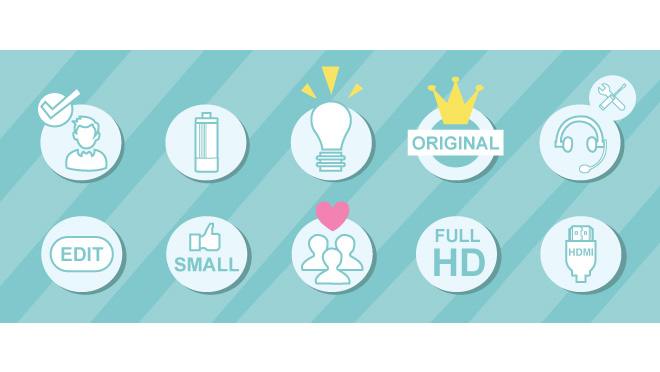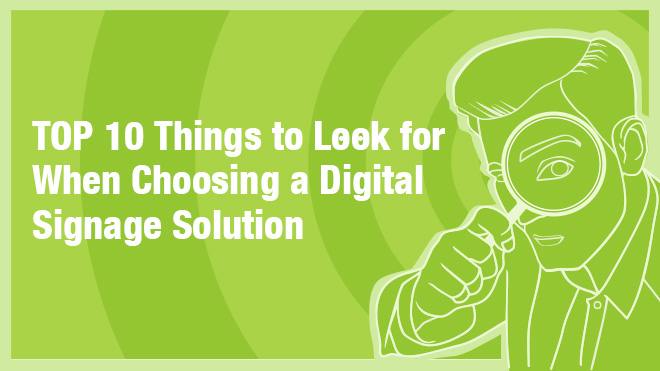The presence of digital signage in your store or restaurant is the key to success in today’s competitive environment. Research recently indicated that a properly created digital signage solution can increase profit by 31%.
To ensure maximum return on investment, here are the top 10 things to look for when you choose a digital signage solution.
Top 10 Tips for Choosing a Digital Signage Software Solution
#1: Professional consultants
A solution provider who’s able to provide professional consultation is critical to the successful implementation of your digital signage. These professional consultants will provide you with suggestions on the size of the display, discussions on creative content, and recommendations on the correct software/hardware solutions that will provide you with exactly what you need. Speaking to an experienced consultant can save you tons of money and hours of research.
#2: Digital signage computer
The most important thing about digital signage is the digital signage computer. It is important not to be confused by the inclination to treat a USB flash drive or a media player as a digital signage computer. It is also important to avoid the use of any Windows or Mac digital signage computer. This is because they are not operating as efficiently as a computer specifically for digital signage. Getting the correct commercial-grade digital signage computer will save thousands of dollars on your future maintenance costs.
#3: Creative design services
Digital signage must be completed with graphic and animation designs. A qualified digital signage solution provider must have an internal creative design team. Finding a solution provider who’s able to provide both static and animated graphics internally is the only way to fully unleash the power of digital signage.
#4: Original software development
The majority of digital signage solution providers are considered system integrators. There is nothing wrong with finding a system integrator to help you set up your very own digital signage. However, when there is something wrong with the software or hardware. The system integrator cannot do anything to fix the problem. He or she will need to escalate the issue to the original software or hardware manufacturer company. Therefore, going with a system integrator often ends up with higher costs and slower services.
#5: Dedicated technical support engineer
There’s a difference between a technical customer service provider vs. a technical support engineer. A technical customer service provider may seem as though he or she can provide help when you are experiencing technical difficulties. However, technical customer service providers are usually only able to provide preliminary support, such as “unplug your power and plug it back in” or “make sure you turn on your TV.”
In contrast, a technical support engineer has access to system-level knowledge that allows him or her to provide help beyond a simple “power cycle.”
Unfortunately, in today’s industry, people no longer differentiate between a technical customer service provider vs. a technical support engineer; instead, such individuals are designated as Technical Support. A quick way to identify true technical support is that the support-providing company must be the company that developed the digital signage software.

#6: Editable contents
Digital signage content needs to be always up-to-date. As most of the users are not graphic artists or animators, it is important to find digital signage software that can provide the ability to modify the contents without affecting the designs. This is another reason why getting a USB flash drive or media player will not be sufficient.
#7: Smaller is better
Many true digital signage providers like to use computers. Some of them are large computers and some of them are mini computers. It is important for your digital signage computer to be as small as possible so that it is not easily visible to the audience.
#8: Past client work
It is very important to look at past clients’ work. Any qualified digital signage company should be able to provide visual examples of real client work. Do not focus on the installation because there’s no real skill involved. Instead, pay attention to the creative contents that they’ve created for their clients. An inability to provide proper portfolios of past design projects typically raises a red flag. You don’t want to waste your time with a digital signage provider who has no experience in designing the contents.
#9: Support native Full-HD
If you believe that all HDMI connections are full HD, then you are wrong. The majority of digital signage hardware and software programs can only support up to 1280 x 720 (720p) resolution while the full HD supports 1920 x 1080 resolutions. When you buy digital signage, make sure that the hardware and software can output at 1920 x 1080 (1080i or 1080p). You don’t want your TV to receive a 720p signal and upscale it to 1080i/1080p.
#10: Simple plug & play hardware
Digital signage hardware should be super simple to install. If there are tons of computer settings and cables and the networking needs to be configured and plugged in, then you should look for something else. The proper solution should only consist of a device that plugs into your HDMI connector with a power cord…nothing more!
You can learn more about NexSigns Digital Signage solution and connect with us on Facebook, LinkedIn, Twitter, and YouTube to get the latest info on digital signage!



